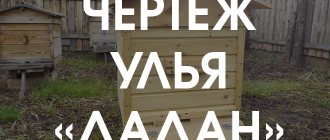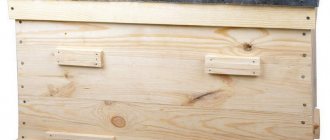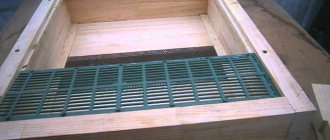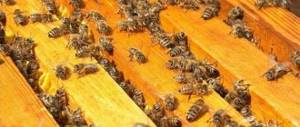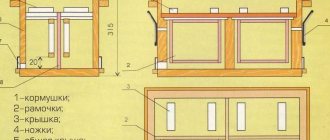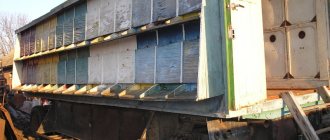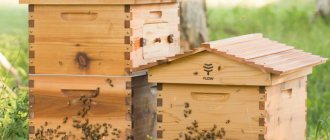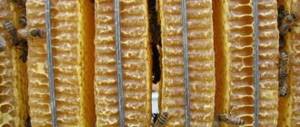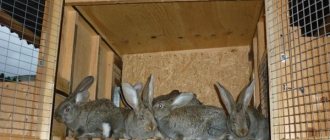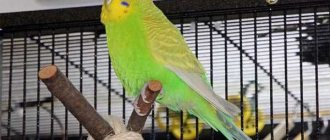Features of keeping bees in polystyrene foam hives
Wintering in multi-hull hives made of polystyrene foam does not involve bringing the hives into a special winter hive. Otherwise, there is a risk that the bees will become exhausted. When preparing families for cold weather, it is enough to move the boxes towards each other. This will keep you warm.
If there are wooden hives in the apiary, it is recommended to plant strong families in them. And leave the weakened layering in polyurethane foam boxes. With the approach of spring, the houses are placed in their places. It is worth noting that the activity of bees in polyurethane hives begins earlier than in wooden hives.
Basic requirements for homemade hives
1. The presence of a ventilation window in the bottom, covered with a fine-mesh metal mesh, and having dimensions of no less than 300 by 300 mm. This window is kept open all year round so that the bees do not get tired during the winter and do not start swarming in the summer from the stuffiness.
2.Use canvas, possibly polyethylene. Some homemade models are equipped with ventilation under the lid:
This is a universal roof that is used in two positions:
- mesh down - for ventilation in summer;
- with the mesh facing up - to ensure a solid ceiling in winter.
Interesting fact: There are recommendations to exclude any ventilation through the ceiling and maintain complete tightness here. It is not known for certain what they are based on.
3. Ensuring a tight fit of the body sections vertically - there should be no gaps that the bees will begin to insulate with propolis! Removing tightly glued parts with a chisel can damage them.
4. A small horizontal play is a mandatory design feature that allows you to carefully remove the body sections. When tearing off the body, you can carefully move it back and forth and left and right. For non-rebated models, no backlash is needed!
Features of beekeeping
In order not to be unfounded, here is a review from Czech beekeeper Petr Havlicek, who tested polyurethane foam hives for several years.
- a microclimate that is exceptional in its properties is created in a bee’s home - nests develop rapidly, starting in early spring;
- each hive rebuilds at least one body of foundation;
- all bee colonies in the multi-hull systems with 4-5 extensions used are quite strong and produce up to 90 kg of marketable honey per season;
- for the winter, the nests do not require reduction, which simplifies the maintenance of the apiary - there is no need to store dry matter, protecting it from moths;
- to prevent swarming, layering should be done in mid-May, reuniting separated families by winter;
- The quality of the hive is enhanced by the use of aluminum foil - it covers the structure from the inside and outside.
Hive assembly
You can make drawings and dimensions for a polystyrene foam hive yourself. This will allow the master to create an exclusive hive that no one else has. Also, by thinking through every detail, you can make the design more convenient to use.
If you follow all the manufacturing rules, as well as using accurate dimensions and verified drawings, you can get great pleasure from the manufacturing process, and the end result will delight you for many years. When making a house for bees, you must remember that the more carefully you approach this matter, the more honey the bee colony will thank you for.
Ascospherosis of bees. Treatment of lime brood
Beekeepers' opinion
The attitude towards polyurethane foam in the beekeeping environment, as well as towards any artificial material, is wary and ambiguous.
There are the most opposite opinions - from moderately positive to sharply negative. Bee hives made of polyurethane foam are considered a source of toxic emissions - the material emits them under the influence of sunlight, as well as as it wears out during use.
But laboratory tests do not show any impurities in commercial honey. To which opponents of polyurethane foam respond - laboratory technicians are not looking for what is needed in the samples to confirm the harmfulness of this material to bees and humans. After all, it is well known that polyurethane foam is not recommended for installation in residential premises in the same way as polystyrene foam or expanded polystyrene such as Penoplex.
All these are insulation materials for external installation on buildings, including residential ones, as well as thermal insulation of various communications and ventilation systems. And in hives made of polyurethane foam or expanded polystyrene, bees are forced to come into direct contact with the building material. It is not known for certain how exactly polyurethane foam affects the resulting bee products.
Another important point is the arrangement of proper ventilation. The PPU construction is in many ways reminiscent of a thermos - it does not “breathe”, which requires the installation of a mesh on the bottom of the hive.
But at the same time, you should not be overzealous with round tap holes in the buildings - unwanted drafts may arise. It is enough to have a lower entrance slot, ventilation in the bottom and lid. However, this also causes heated debate - each beekeeper acts at his own discretion based on his own experience of using polymer hives.
Many people are put off by the price. One Dadanovsky building will cost the owners an average of 1,110-1,250 rubles (that’s what the well-known Nizhegorodets on the market costs).
Hive: high bottom using German technology
About the material
Polyurethane foam is used in industry and construction more widely than other types of foamed polymers due to its plasticity. Its structure resembles frozen foam. Consists of synthetic polymers filled with gas.
PU foam hives are assembled from a rigid version of this material - ready-made sheets or self-foaming compounds in the form of a fill.
- excellent waterproofing characteristics;
- good adhesion – adhesion is ensured at the molecular level;
- low permeability to steam;
- low thermal conductivity.
PU foam does not become moldy and does not attract rodents, ants and other apiary pests. It is light in weight - three Rutov cases with a wall thickness of 35 mm weigh 17 kilograms. Resistant to mechanical stress. Provides high-quality sound insulation.
The only drawbacks are:
- fear of ultraviolet rays - the material must be hidden from the sun;
- highly flammable - burns quickly, releasing toxic substances.
The main purpose of polyurethane foam, according to SNiP 23-02-2003, is to protect buildings from cold and heat loss. The most well-known variety in everyday life is polyurethane foam, consisting of one component. And the most widespread are two-component compositions (polyol plus polyisocyanate, the reaction requires water).
Design features of polyurethane foam hives Nizhny Novgorod
In Russia, hives can also be made of artificial synthetic material - polyurethane foam. This design has long been valued in Sweden, Germany, Finland, and Poland.
Russian polyurethane foam hive Nizhny Novgorod, manufactured using molds, is not exposed to acid, alkali, salt, or paints. The PU hive does not require additional painting; it only needs to be primed at the molding stage. You can paint the hive with various paints (even with solvents) if desired. Beehives made of polyurethane foam are not subject to destruction by rodents.
The design of Nizhny Novgorod is not cellular. If dropped, the housing with frames may break at the joints. It has low thermal conductivity, which allows bees to feel comfortable in the cold season.
The Nizhny Novgorod polyurethane foam hive is made from environmentally friendly material, for which a sanitary certificate is given. The manufacturer pays attention to all shortcomings. All structural elements are solid. The polyurethane foam body is rigid, durable, and does not collapse over time.
All elements are connected using seam joints, which ensure strength and reliability. The Nizhegorodets hive provides for a backlash horizontally located between the housings. This way you can quickly separate the polished structure.
Beehives made of polyurethane foam are characterized by increased density. There is no need to place inserts under the frames. There are elongated handles on the sides for the beekeeper’s convenience when lifting the hive using an apilift, which is reliable and safe.
It is important to choose a mesh bottom complete with a sliding full-fledged tap hole. The PU hive can be painted with different paints. For technological purposes, when making a hive using molds, an anti-adhesive lubricant is used, so the polyurethane foam does not stick to the mold. Acrylic paint is not suitable in this case, as it often comes off in whole pieces. Afterwards, fuzzy edges and blurred edges appear.
However, sometimes wax may remain on some structural parts of the hive after production. The manufacturer takes this into account and uses sandpaper to burn the wax in the sun.
If you decide to make a polyurethane hive using molds, you must take into account all the nuances. This is the only way you will get a lightweight, durable, reliable, comfortable design. In Russia, such a hive has just begun to become popular; abroad it has long been valued in beekeeping. During production, it is necessary to rely on the experience of beekeepers from different countries.
When making a polyurethane foam hive with your own hands, be sure to use high-quality molds. This design is distinguished by its thermal insulation and waterproofing.
Design Features
The production of hives from polyurethane foam on an industrial scale is focused on the most popular systems - Dadans and multi-body Rutas. 10- and 12-frame Dadans from one or two cases with two magazines are sold, as well as 10-frame Rutas from 4-5 cases.
To preserve the material from exposure to direct sunlight, high-quality water-based acrylic paint is used. Barriers are not provided for the tapholes, but you can install them yourself.
How to keep bees
Basic requirements for homemade hives:
1. The presence of a ventilation window in the bottom, covered with a fine-mesh metal mesh, and having dimensions of no less than 300 by 300 mm. This window is kept open all year round so that the bees do not get tired during the winter and do not start swarming in the summer from the stuffiness.
The uniqueness of polyurethane foam hives
Polyurethane foam was synthesized in 1937 by German scientists. This is the name given to a group of gas-filled polyurethane-based plastics. Polyurethane foam is widely used in construction, for example, for insulation, heat and sound insulation, or as a sealant (spray foam), in everyday life, and in industry. This is a very light, durable material, characterized by low thermal conductivity and vapor permeability and good adhesion to other materials. In foreign beekeeping, this material has been used for the production of hives since the 60s of the last century. Domestic beekeepers adopted this technology not so long ago, having seen from their own experience its many advantages and learned about its disadvantages.
Advantages and disadvantages of this raw material
You can make hives made of polyurethane foam or polyurethane foam with your own hands. These designs have many advantages:
- easy transportation;
- have thermal insulation properties;
- in such hives there is no noise transmission into the structure;
- care is very simple;
- polyurethane foam does not absorb moisture;
- parts can be swapped;
- the process of installation and dismantling is quite simple and understandable;
- hives made of polyurethane foam intended for bees are not subject to rotting or corrosion;
- long period of use;
- In such hives, bees do not require additional insulation.
Each beekeeper has the opportunity to assemble hives from polyurethane foam for his bees with his own hands if he prepares all the necessary materials and a drawing on which all the parameters and measurements will be noted.
In addition to the advantages, hives made of materials such as polyurethane foam have some disadvantages:
- very high degree of ignition, flammability;
- if there is no normal ventilation in the hives, then moisture will drain to the bottom;
- no air flow is provided.
The importance of swarm and fistula queen cells for the beekeeper
As for the cost, such bee hives are much more expensive than those made from other artificial materials. This is due to the fact that polyurethane foam has many advantages, the main of which are long-term operation and strength.
Advantages and disadvantages
Traditional wooden structures are in many ways inferior to houses made of polyurethane foam and polypropylene foam:
- polystyrene foam hives do not rot or mold;
- high thermal insulation characteristics;
- polyurethane foam hives are safe for insects and people;
- good sound insulation;
- light weight of the finished hive;
- the house is spacious and suitable for a large bee colony;
- easy to assemble and disassemble;
- protected from overheating in summer;
- strength.
Bee hives made of polyurethane foam are easy to disassemble. Since all elements are interchangeable, the finished structure can be increased or decreased in size.
Houses made from polyurethane foam also have disadvantages:
- the hulls are not cleaned of propolis. Along with the valuable substance, crumbs of PPS and PU foam fall off;
- problems with performing disinfection;
- The condensate released accumulates at the bottom of the hive. Since the material does not absorb moisture;
- low strength.
Another disadvantage of PU foam is its lightness. In strong gusts of wind or storms, hives can be blown away. Therefore, it is necessary to strengthen the structures.
Polyurethane structures
A hive made from a material such as polyurethane is distinguished by its extraordinary lightness, high quality and extraordinary strength.
Such insect housing contains the following components:
- bottom equipped with anti-mite galvanized mesh;
- pallet made of plexiglass, galvanized sheet, plywood or MDF;
- main body;
- cover with two levels of adjustment;
- a frame that will allow you to breed two queens.
All components of the case are assembled using special screws, but it is advisable to coat the joint areas with appropriate glue. This type of material, such as polyurethane, deteriorates when directly exposed to sunlight, so it is painted. The construction made of polyurethane foam has a significant drawback, which is associated with the short period of its use, namely, no more than five years. For this reason, the cost of such bee hives is much lower than others.
These structures are made using environmentally friendly material that has a sanitary certificate. Each element is fastened with a seam connection in accordance with the drawing, which increases the reliability and strength of the structure.
It is important to note the high density of the house. Handles are built on the sides. No inserts are placed under the frames. During the assembly process, as a rule, a mesh bottom is selected, which is equipped with a full-fledged sliding taphole.
If you take into account technological goals and use molds, you will need an anti-adhesive lubricant so that the raw materials do not stick to the molds.
When constructing such hives, do not use acrylic paint, as it comes off in pieces over time.
Pay attention to the quality and strength of the mold, as the quality of operation depends on this. In this way, you can provide reliable and effective waterproofing, as well as thermal insulation, which is important for the microclimate in bee houses.
If you want to purchase a similar model for your own apiary, choose the highest quality, harmless materials so as not to harm the inhabitants of these houses. It’s easy in such hives
Technology for manufacturing hives from polyurethane foam
Polyurethane foam hives are made using relatively simple technology. They can be made in one piece (using the mold casting method) or in panels. With a panel construction, individual covers, walls and other parts are connected using polymer glue and self-tapping screws.
Molds used to cast polyurethane foam must be able to withstand the stresses of reaction expansion. A release agent is applied to the inner walls of these molds to minimize the adhesion of polyurethane foam to the mold material. The components that form polyurethane foam are poured into a mold using special equipment (filling machine “NAST-10”, “NAST-14” or “UZK-22”). The mass of each filling is clearly dosed depending on the geometric dimensions of the future hives. After joining, the components foam, occupying the entire space of the mold, and harden. Once removed from the mold, the polyurethane foam hive is ready. The only thing that needs to be done is to apply a layer of protective paint on top to protect the polyurethane foam from the destructive effects of sunlight. Polyurethane foam is not afraid of other natural influences.
Making beehives from polyurethane foam with your own hands at home
The process of making a hive at home.
The first step is to purchase pine boards. Their thickness must be at least 25 millimeters. It is important that they are dried as best as possible. Humidity should not exceed 15 percent.
Next, a pallet is made from the boards, the height of which should be 120 millimeters. There should be a grid in the floor. There should also be a rear debris removal door and a front slot caster. You should also take care of the liner to control the winter or summer passage.
The walls of the housings must be mounted using solid five-centimeter polyurethane foam covered with aluminum foil. All parts must be attached to the groove with polyurethane glue. A fold is selected separately for the upper cut, the height of which is approximately 10 millimeters. It is necessary for more reliable hanging of frames. All this is secured using a wooden insert, which should be installed in the grooves.
Next, two wooden straps in the form of an upper and lower frame are fixed to the outside of the hive body. The parts must be secured with glue, however, for greater reliability, it does not hurt to fix them with screws. Their length should not exceed 9 centimeters.
To ensure ventilation, small holes should be made in the corners of the structure. To prevent the bees from flying out, the holes can be covered with a net. There should be no free space under the frames, but above the frame it should be no more than 7 millimeters.
The last detail for the future hive is the lid. In order to make it, you need to stuff the shield onto the harness. It is also important to ensure that the cover is protected from rain and snow - for this it is best to use galvanized iron or any other protective materials.
Now the hive is ready and you can paint it. Making a hive according to this plan is quite easy, which is why all novice beekeepers use it.
Beehives made of polyurethane foam can be purchased ready-made. Today there are many models on the market from various ones, “Khimekselen”, “Bdzholyar”, “Nastusya”, “Khimtrast”, etc. It is also possible to make houses for bees with your own hands, starting from pouring the body.
You can quickly make a hive from polyurethane foam, but you will need certain knowledge and skills. It is important to prepare the necessary materials, tools and components for pouring, and also strictly follow the manufacturing instructions. The recommended temperature in the room where the hive is made is +18...+25°C.
Necessary materials and tools for work
To make a polyurethane foam house for bees you will need:
- molds for making the body;
- release agent;
- roller;
- 2 containers for filling components (0.5 l plastic buckets are suitable);
- a wooden spatula (kitchen) or trowel for cleaning out the remaining filler from the bottom;
- a special mixer or drill with an attachment for mixing paint and concrete;
- components for pouring polyurethane foam - polyol and isocyanate;
- kitchen scales for accurately measuring doses of components;
- screwdriver (screwdriver);
- self-tapping screws
Types of spring work with bees and methods for carrying them out in the apiary
Step-by-step manufacturing instructions
It takes about 1.5 hours to make parts for the body of one hive. No additional drawings are required, since pouring using ready-made molds and assembling the body is quite simple.
To make the walls, roof and bottom, you need to perform the following steps:
- Coat the insides and projections of all molds well with release agent using a roller.
- Leave until the grease dries completely.
- Place the molds at a slight angle for better distribution of the potting mixture.
- Prepare the required number of components for pouring.
- Pour the isocyanate into the polyol and very quickly - within 10-20 seconds - mix the components until smooth with a drill attachment and pour into one of the molds.
- Cover the mold with a lid and secure with latches.
- Open the lid after 40–60 minutes.
- Fill the molds for the walls, roof and bottom in the same way. Before each subsequent pouring, the mold must be cooled to +45°C and below.
Assemble the hive body as follows:
- Connect the dovetail joints of the walls.
- Alternately connect each pair of upper and lower joints, central parts using self-tapping screws.
- Apply paint used for exterior use, such as ENAMEL, PF, etc., to the outer casing.
maintain an optimal climate for insects.
Polyurethane foam hives
Polyurethane foam is a relatively new synthetic material; bee houses have only been made from it for the last 30 years. Today it is a known fact that almost half of the hives are made of polyurethane foam . The material gained such popularity due to its many advantages.
Advantages
- This material is not susceptible to rotting and mold, as it has good moisture resistance.
- It has good thermal insulation properties, thanks to which the optimal temperature for bees is always maintained inside the house, both in winter and summer.
- Polyurethane foam structures have good strength and a long service life.
- The material is not dangerous for either bees or humans, as it is considered environmentally friendly, however, when purchasing, you need to check whether there are any odors inside the structure, because bees are very sensitive to foreign odors. In addition, honey has the ability to absorb foreign odors. If odors are present, this indicates poor quality of the material.
- Polyurethane foam hives have good sound insulation.
- The structures are very easy to maintain.
- The houses are light in weight.
- The structures are very spacious and perfect for large families.
- They are easy to assemble and disassemble, which is very convenient when collecting honey.
- The hive can be quickly and easily either reduced or enlarged, since all the parts perfectly replace each other.
Homemade wax melters for apiary lovers
Although polyurethane foam has many advantages, there are still some disadvantages that must be taken into account.
Disadvantages of polyurethane foam hives
- Polyurethane foam can deteriorate when exposed to direct sunlight, so in order to extend the life of the houses, they must be painted on the outside.
- Structural parts will have to be replaced periodically (every five years).
- Since the weight of the houses is small, it will have to be additionally weighted so that they do not fall during gusts of wind.
- Not very good ventilation.
- The price for hives made of polyurethane foam is slightly higher than for other artificial materials.
In order to assemble a hive from polyurethane foam with your own hands, you will need a little knowledge and just a little time. The process of assembling a polyurethane foam hive is:
- The outer surface of the parts is degreased.
- The outside of the parts is painted; it is better to apply two layers of paint.
- Then you need to assemble the existing parts.
If you plan to make a polyurethane foam hive entirely with your own hands, then you should buy the necessary material in advance. And make from them the required number of parts that make up the structure itself.
Using casting molds
If you use a self-foaming composition at home, you will need special forms for hives made of polyurethane foam. Two-component polyurethane foam is suitable for filling, for example, the Vladimur 3017-1p or Izolan system.
To prevent the polyurethane foam from sticking to the mold parts, the inside is treated with wax dissolved in gasoline. There is enough lubricant to assemble four housings. Then the processing is repeated. This is the advice of one of the folk craftsmen, whose video lesson is given at the end of the article.
To manufacture mold parts for a 10-frame Dadan, sheet metal is used, from which blanks of suitable height are cut using a grinder, a template, a ruler and clamps (for example, for a half-frame magazine, the height is 155 mm).
If the workpiece has bends, it is leveled with a hammer - straightened on a flat surface. Four parts are cut from the blanks for the inner and outer walls of the mold, which are temporarily grabbed for assembly - welded using a corner.
All joints are checked with an angle - maintained strictly at 90 degrees. The top and bottom of the mold are also welded from sheet iron. Holes for filling are drilled at the top.
The length of the upper and lower parts in the example given is: 500 mm front and rear walls, 410 mm sidewalls. Stops for the wall are 12 mm squares.
On the outside of the inner walls, 12 by 12 mm stops are welded under the hangers of the frames. Interwall space 40 mm.
Rings are also welded onto the inner walls from the inside of the structure to install the screed during pouring of the body. The top and bottom of the form are fastened with pins. Temporary clamps on the corners are cut off with a grinder
During the pouring process, the mounting holes are covered with plugs for a while.
Using a grinder allows you to save on cutting sheets with a guillotine. But for work you will need a supply of disks. On average, one cut (cutting out one workpiece in the form of a long sheet) takes 15 minutes.
Instructions for creating evidence from polystyrene foam
The quality of the finished structure will depend on the next stage of work, namely assembly. After preparing the parts, we will begin their assembly, which should be performed in a certain sequence. Let's look at the step-by-step assembly of the entire structure:
- along the edge of each wall you need to cut a “four”, which will be needed to tightly connect the fragments;
- Apply liquid nails to the joint. We attach two walls (grooves to the protrusions);
- We connect the walls, and they should be pressed tightly against one another. We are waiting for the joints to dry;
- We tighten the structure using self-tapping screws and fix it. At the same time, we observe a step of 9 - 12 cm. It is advisable to deepen the caps 5 - 6 mm inside the walls;
- We assemble finished buildings;
- check for gaps and cracks.
In this simple way you can make a polystyrene foam hive with your own hands.
What is included in the design of a foam plastic hive, what will be the weight of the future structure. The weight of the case (without frames) will be 12 – 14 kg, which is quite a bit compared to wood. Polyurethane foam hives include the following parts:
- Ten-frame cases 435 by 230 mm (4 pieces).
- Lid.
- Bottom. This part consists of a bottom, an anti-mite mesh, a landing board, a tray, and a liner with a valve for the tap hole.
- Feeder.
Why do you need canvas in a hive?
The anti-tick mesh is made from galvanized mesh with a mesh size ranging from 2 to 3 mm. A heating device with a power of 10 W is attached to the grid. The wire from such a heating device goes to a plug, which is located on a wooden insert.
A very important point is to connect the heating device to the thermostat. This procedure is performed after the end of the autumn nest formation. Inside the control hive, the temperature during the wintering period should be within 2 - 4 degrees. Thus, the food is consumed more economically, and the humidity inside the housing does not exceed the norm.
To make a pallet we need galvanized sheet metal. This part of the hive is necessary to control wintering. Thanks to the tray, you can determine the level of mite infestation of bees and the presence of ascopherosis (this is evidenced by mummified brood). When transporting hives, the pallet must be removed. This is necessary to prevent the bee colony from becoming steamed. During the transportation of hives, it is recommended to clean and disinfect the pallets.
When producing hives, you need to take into account the thickness of the walls. The front and rear walls should be 35 mm each, and the side walls should be 25 mm each. All walls have recesses for handles. The flywheel is located on the front wall. There is an aluminum valve on the tap hole. Ventilation holes are made on the lid.
Feeders should be made of nomadic mesh, the size of its cells in mm is 3 x 3. For the winter, the nomadic mesh is covered with polystyrene foam insulation. During transportation, this mesh is removed and the insulation is transferred to the feeder.
Video: a polystyrene foam hive at home.
How does the material affect the quality of honey?
Poles and Finns were the first to produce PPU and PPS hives. Later, domestic beekeepers began to resort to the material. Our beekeepers were wary of polyurethane foam. Because styrene accumulates in the body of insects and in bee products. However, there was no scientific confirmation of the harmfulness of the polyurethane foam material. Studies show that the accumulation of styrene is negligible, and they are safe for insects and honey products.
SES services do not inspect hives made from polyurethane foam. The examinations have proven that the material is completely safe, does not affect the quality of honey and can be used for the construction of apiaries.
Material advantages
Polyurethane foam for the manufacture of hives began to be used not so long ago, only about 30 years ago. But already approximately 50% of all bee houses existing in different countries of the world are made of this material. This is primarily due to the numerous positive characteristics of polyurethane foam, such as:
- Unlike wood, this synthetic material does not rot;
- Mold and other types of fungi do not form on its surface;
- For hives, polyurethane foam provides high thermal insulation characteristics, which gives the bee colony a better chance of surviving adverse weather conditions and sudden temperature changes;
- The mechanical properties of the material are quite high, which ensures long-term operation of the hive without its destruction or changes in design parameters;
- Bee houses made of polyurethane foam are environmentally friendly, but only if the material is of high quality, which the beekeeper must ensure when purchasing such a product;
- High sound insulation will allow the family to quietly conduct their activities without the formation of irritating factors;
- Easy to care for;
- The low weight of the structure makes it easy to move polyurethane hives when moving the apiary to another place;
- The spacious volume of hives made of polyurethane foam allows you to accommodate large families;
- During honey collection, such a structure is quite easy to dismantle, which makes the beekeeper’s work easier;
- Thanks to the modular system for organizing the finished product, it is easy to adapt the house to a small or large family. This is done by simply replacing individual elements, which allows you to make a larger or smaller hive.
Naturally, all of the above properties are undeniable advantages of polyurethane foam used as a material for the manufacture of bee houses. But, before purchasing such a product for yourself or making it yourself, it is necessary to analyze its possible effect on honey, as well as analyze the shortcomings and features.
